Charles M. Kozierok The TCP-IP Guide
Подождите немного. Документ загружается.

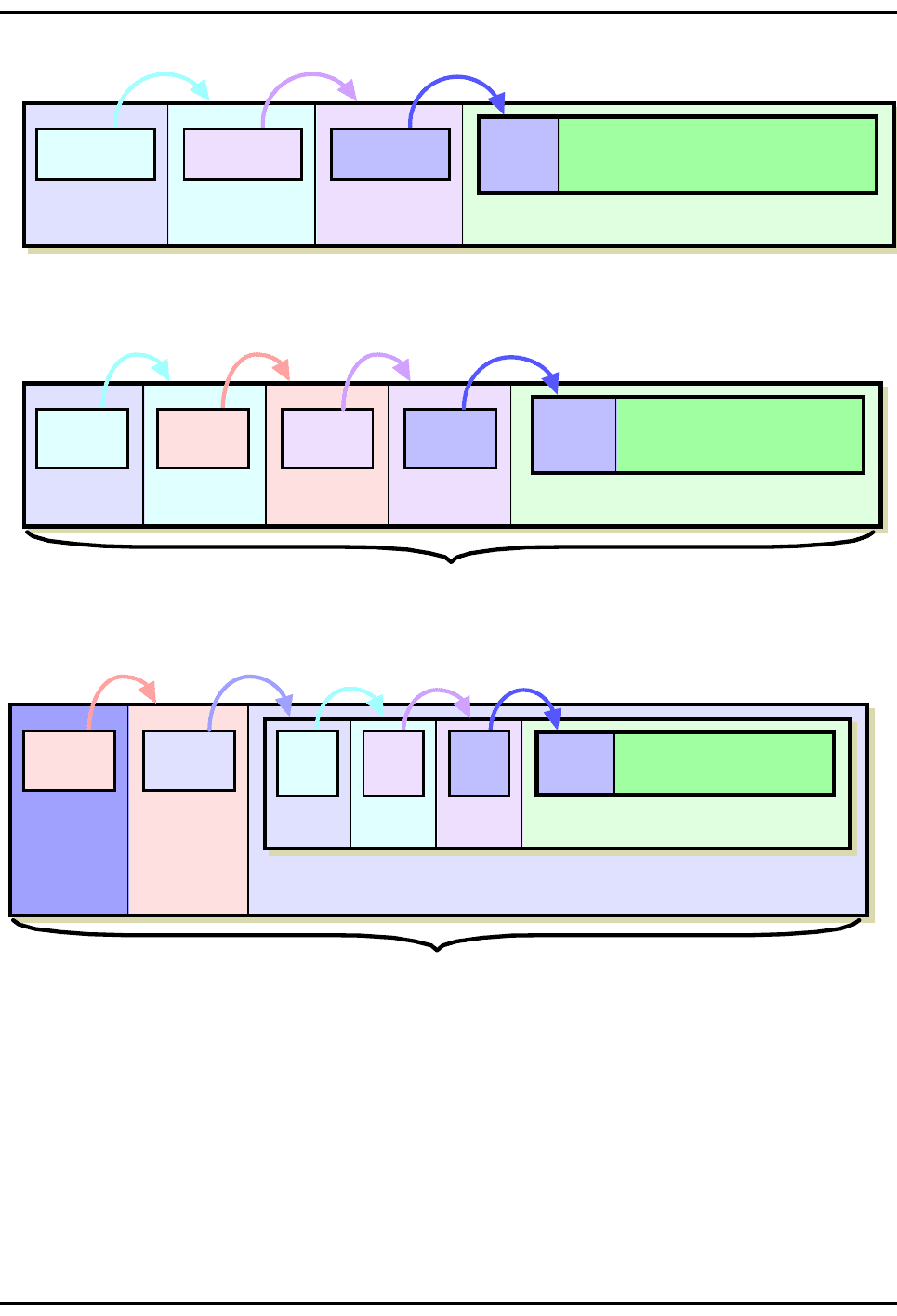
The TCP/IP Guide - Version 3.0 (Contents) ` 561 _ © 2001-2005 Charles M. Kozierok. All Rights Reserved.
Figure 121: IPv6 Datagram Format With IPSec Authentication Header (AH)
At top is an example IPv6 datagram with two extension headers linked using the standard IPv6 mechanism
(see Figure 106.) When AH is applied in transport mode, it is simply added as a new extension header (shown
in pink) that goes between the Routing extension header and the Destination Options header. In tunnel mode,
the entire original datagram is encapsulated into a new IPv6 datagram that contains the Authentication
Header. In both cases the Next Header fields are used to link each header one to the next. Note the use of
Next Header value 41 in tunnel mode, which is the value for the encapsulated IPv6 datagram.
Original IPv6 Datagram Format (Including Routing Extension
Header and Destination-Specific Destination Options Extension Header)
IPv6 Header
Routing Exten-
sion Header
Destination
Options Header
IP Data
TCP
Header
TCP Segment Data
Next Header
60
Next Header
43
Next Header
6
New IPv6
Header
Auth
Header
Original IPv6 Datagram
(Encapsulated)
IPv6 Header
Routing Ext
Header
Des t
Options Hdr
IP Data
TCP
Header
TCP Data
Nex t
Header
6
Nex t
Header
60
Nex t
Header
43
IPv6 Header
Routing Ext
Hdr
Auth
Header
Dest Op-
tions Hdr
IP Data
TCP
Header
TCP Data
Nex t
Header
6
Nex t
Header
60
Nex t
Header
43
Nex t
Header
51
Authenticated Fields
IPv6 AH Datagram Format - IPSec Transport Mode
Authenticated Fields
Nex t
Header
51
Nex t
Header
41
IPv6 AH Datagram Format - IPSec Tunnel Mode
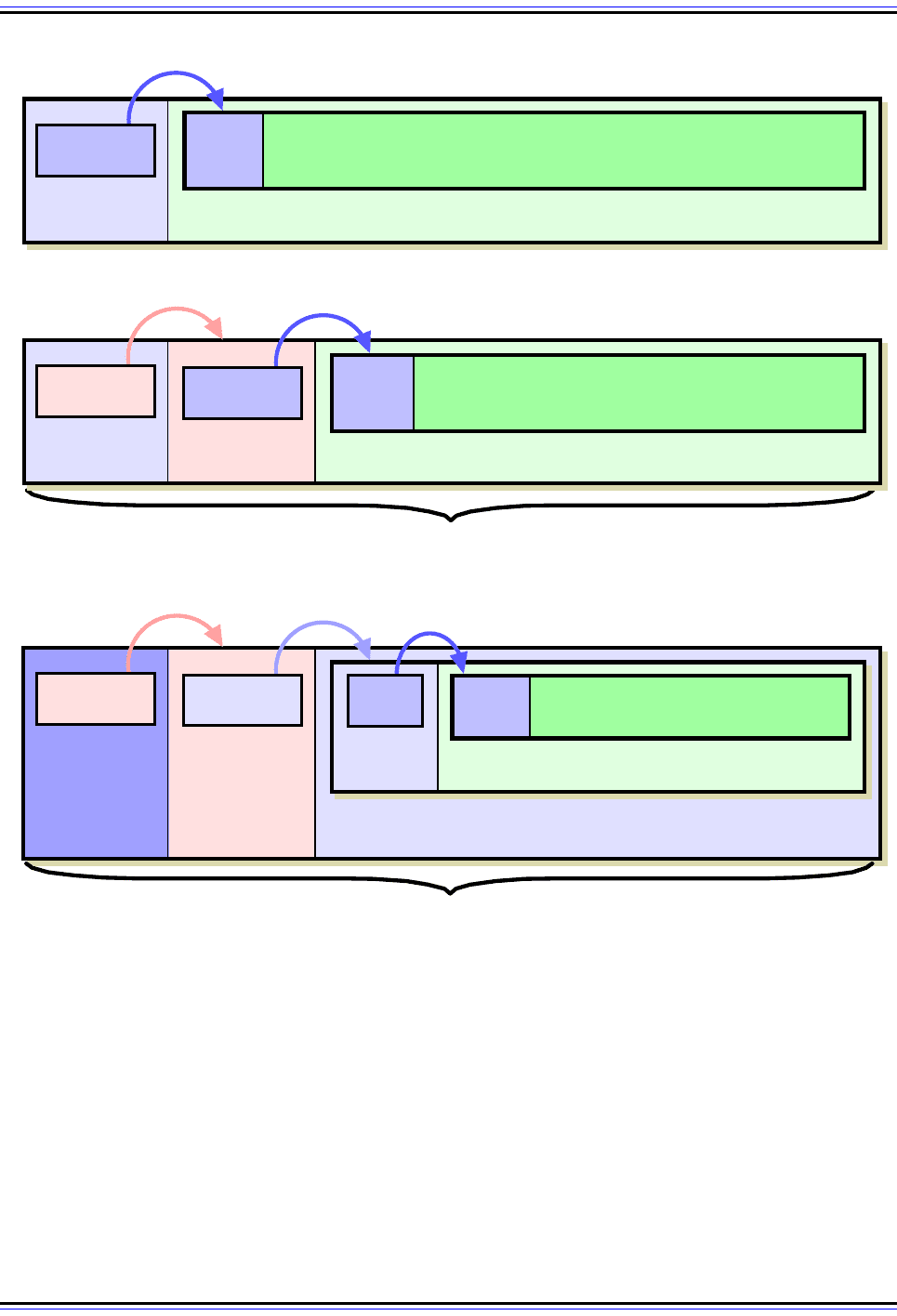
The TCP/IP Guide - Version 3.0 (Contents) ` 562 _ © 2001-2005 Charles M. Kozierok. All Rights Reserved.
Figure 122: IPv4 Datagram Format With IPSec Authentication Header (AH)
At top is an example IPv4 datagram; it may or may not contain IPv4 options (which are not distinct entities as
they are in IPv6). In transport mode, the authentication header is added between the IP header and the IP
data; the Protocol field of the IP header points to it, while its Next Header field contains the IP header’s prior
protocol value (in this case 6, for TCP.) In tunnel mode the IPv4 datagram is encapsulated into a new IPv4
datagram that includes the AH header. Note in tunnel mode, the AH header’s use of the value 4 (which means
IPv4) in its Next Header.
Original IPv4 Datagram Format
IPv4 Header IP Data
TCP
Header
TCP Segment Data
Protocol
6
New IPv4
Header
Authentication
Header
Original IPv4 Datagram
(Encapsulated)
IPv4 Header IP Data
TCP
Header
TCP Data
Protocol
6
IPv4 Header
Authentication
Header
IP Data
TCP
Header
TCP Data
Authenticated Fields
IPv4 AH Datagram Format - IPSec Transport Mode
IPv4 AH Datagram Format - IPSec Tunnel Mode
Protocol
51
Next Header
6
Protocol
51
Next Header
4
Authenticated Fields

The TCP/IP Guide - Version 3.0 (Contents) ` 563 _ © 2001-2005 Charles M. Kozierok. All Rights Reserved.
Authentication Header Format
The format of the Authentication Header itself is described in Table 80 and shown in Figure
123.
Table 80: IPSec Authentication Header (AH) Format
Field Name
Size
(bytes)
Description
Next Header 1
Next Header: Contains the protocol number of the next header after the
AH. Used to link headers together.
Payload Len 1
Payload Length: Despite its name, this field measures the length of the
authentication header itself, not the payload. (I wonder what the history is
behind that!) It is measured in 32 bit units, with 2 subtracted for consistency
with how header lengths are normally calculated in IPv6.
Reserved 2 Reserved: Not used; set to zeroes.
SPI 4
Security Parameter Index (SPI): A 32-bit value that when combined with
the destination address and security protocol type (which here is obviously
the one for AH) identifies the security association to be used for this
datagram. See the topic on security associations for more details.
Sequence
Number
4
Sequence Number: This is a counter field that is initialized to zero when a
security association is formed between two devices, and then incremented
for each datagram sent using that SA. This uniquely identifies each
datagram on an SA and is used to provide protection against replay attacks
by preventing the retransmission of captured datagrams.
Authentication
Data
Variable
Authentication Data: This field contains the result of the hashing
algorithm performed by the AH protocol, the Integrity Check Value (ICV).
Figure 123: IPSec Authentication Header (AH) Format
Next Header Payload Length Reserved
Security Parameter Index (SPI)
Sequence Number
Authentication Data
(Integrity Check Value)
4 8 12 16 20 24 28 320

The TCP/IP Guide - Version 3.0 (Contents) ` 564 _ © 2001-2005 Charles M. Kozierok. All Rights Reserved.
The size of the Authentication Data field is variable to support different datagram lengths
and hashing algorithms. Its total length must be a multiple of 32 bits. Also, the entire header
must be a multiple of either 32 bits (for IPv4) or 64 bits (for IPv6), so additional padding may
be added to the Authentication Data field if necessary.
You may also notice that no IP addresses appear in the header, which is a prerequisite for it
being the same for both IPv4 and IPv6.
IPSec Encapsulating Security Payload (ESP)
The IPSec Authentication Header (AH) provides integrity authentication services to IPSec-
capable devices, so they can verify that messages are received intact from other devices.
For many applications, however, this is only one piece of the puzzle. We want to not only
protect against intermediate devices changing our datagrams, we want to protect against
them examining their contents as well. For this level of private communication, AH is not
enough; we need to use the Encapsulating Security Payload (ESP) protocol.
The main job of ESP is to provide the privacy we seek for IP datagrams by encrypting them.
An encryption algorithm combines the data in the datagram with a key to transform it into an
encrypted form. This is then repackaged using a special format that we will see shortly, and
transmitted to the destination, which decrypts it using the same algorithm. ESP also
supports its own authentication scheme like that used in AH, or can be used in conjunction
with AH.
Encapsulating Security Payload Fields
ESP has several fields that are the same as those used in AH, but packages its fields in a
very different way. Instead of having just a header, it divides its fields into three
components:
☯ ESP Header: This contains two fields, the SPI and Sequence Number, and comes
before the encrypted data. Its placement depends on whether ESP is used in transport
mode or tunnel mode, as explained in the topic on IPSec modes.
☯ ESP Trailer: This section is placed after the encrypted data. It contains padding that is
used to align the encrypted data, through a Padding and Pad Length field. Interest-
ingly, it also contains the Next Header field for ESP.
☯ ESP Authentication Data: This field contains an Integrity Check Value (ICV),
computed in a manner similar to how the AH protocol works, for when ESP's optional
authentication feature is used.
There are two reasons why these fields are broken into pieces like this. The first is that
some encryption algorithms require the data to be encrypted to have a certain block size,
and so padding must appear after the data and not before it. That's why padding appears in
the ESP Trailer. The second is that the ESP Authentication Data appears separately
because it is used to authenticate the rest of the encrypted datagram after encryption. This
means it cannot appear in the ESP Header or ESP Trailer.

The TCP/IP Guide - Version 3.0 (Contents) ` 565 _ © 2001-2005 Charles M. Kozierok. All Rights Reserved.
Encapsulating Security Payload Operations and Field Use
Let's try to explain this procedurally, by considering three basic steps performed by ESP.
1. Header Calculation and Placement
The first thing to consider is how the ESP header is placed; this is similar to how AH works:
☯ IPv6: The ESP Header is inserted into the IP datagram as an extension header,
following the normal IPv6 rules for extension header linking. In transport mode, it
appears before a Destination Options header containing options intended for the final
destination, but after any other extension headers, if present. In tunnel mode, it
appears as an extension header of the new IP datagram that encapsulates the original
one being tunneled. This can be seen in Figure 124.
☯ IPv4: As with the AH, the ESP Header is placed after the normal IPv4 header. In
transport mode, it appears after the original IP header; in tunnel mode, after the IP
header of the new datagram encapsulating the original. This is shown in Figure 125.
2. Trailer Calculation and Placement
The ESP Trailer is appended to the data to be encrypted. ESP then performs the
encryption. The payload (TCP/UDP message or encapsulated IP datagram) and the ESP
trailer are both encrypted, but the ESP Header is not. Note again that any other IP headers
that appear between the ESP header and the payload are also encrypted. In IPv6 this can
include a Destination Options extension header.
Normally, the Next Header field would appear in the ESP header and would be used to link
the ESP header to the header that comes after it. However, the Next Header field in ESP
appears in the trailer and not the header, which makes the linking seem a bit strange in
ESP. The method is the same as that used in AH and in IPv6 in general, with the Next
Header and/or Protocol fields used to tie everything together. However, in ESP the Next
Header field appears after the encrypted data, and so “points back” to one of the following:
a Destination Options extension header (if present), a TCP/UDP header (in transport mode)
or an IPv4/IPv6 header (in tunnel mode). This too is shown in Figure 124 and Figure 125.
3. ESP Authentication Field Calculation and Placement
If the optional ESP authentication feature is used, the authentication field is computed over
the entire ESP datagram (except the Authentication Data field itself, of course). This
includes the ESP header, payload and trailer.
Key Concept: The IPSec Encapsulating Security Payload protocol allows the
contents of a datagram to be encrypted, to ensure that only the intended recipient is
able to see the data. It is implemented using three components: an ESP Header
added to the front of a protected datagram, an ESP Trailer that follows the protected data,
and an optional ESP Authentication Data field that provides authentication services similar
to those provided by the Authentication Header (AH).
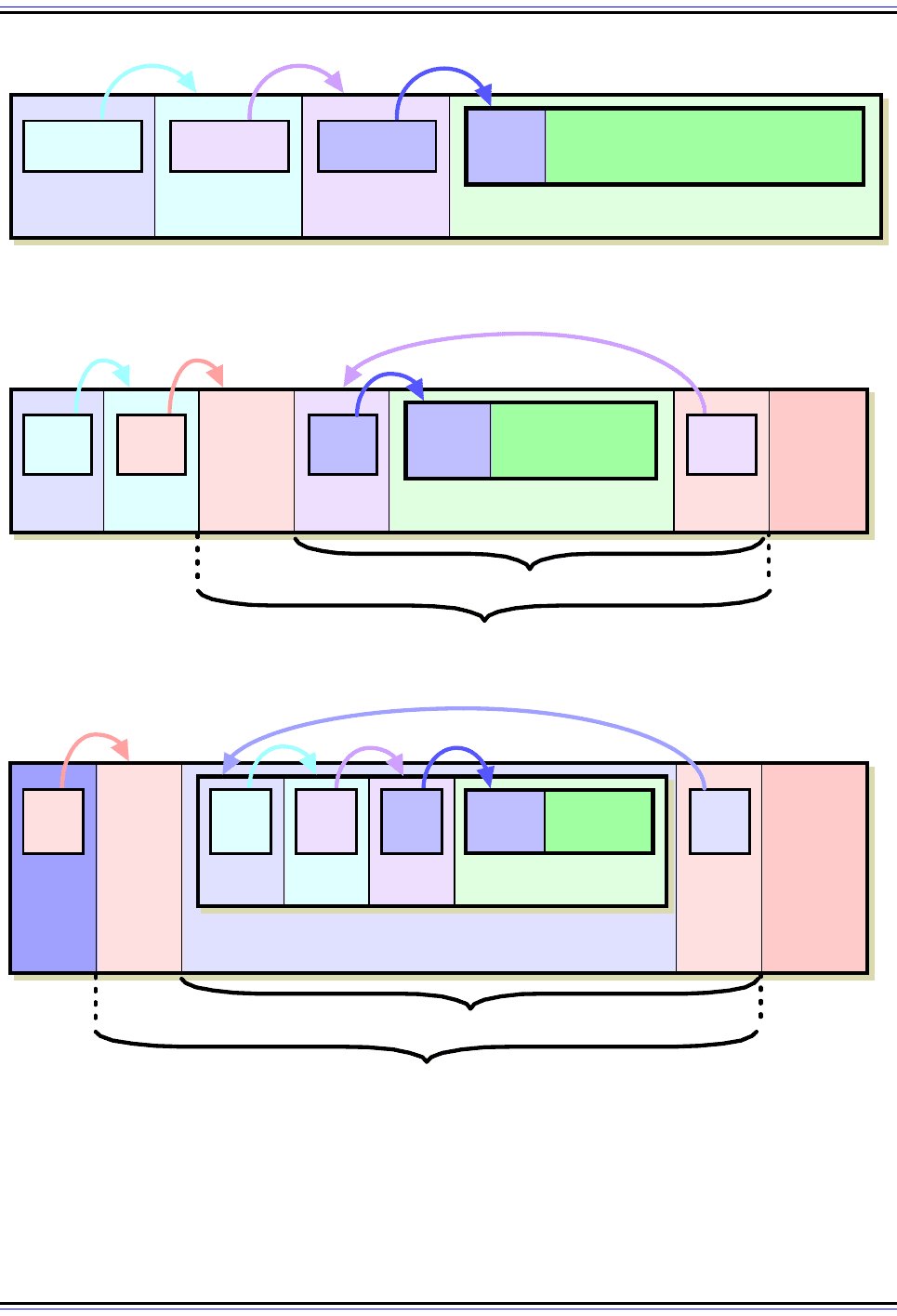
The TCP/IP Guide - Version 3.0 (Contents) ` 566 _ © 2001-2005 Charles M. Kozierok. All Rights Reserved.
Figure 124: IPv6 Datagram Format With IPSec Encapsulating Security Payload (ESP)
At top is the same example IPv6 datagram with two extension headers shown in Figure 121. When ESP is
applied in transport mode, the ESP Header is added to the existing datagram as in AH, and the ESP Trailer
and ESP Authentication Data are placed at the end. In tunnel mode, the ESP Header and Trailer bracket the
entire encapsulated IPv6 datagram. Note the encryption and authentication coverage in each case, and also
how the Next Header field “points back” into the datagram since it appears in the ESP Trailer.
Encrypted Fields
Authenticated Fields
Original IPv6 Datagram Format (Including Routing Extension
Header and Destination-Specific Destination Options Extension Header)
IPv6 Header
Routing Exten-
sion Header
Destination
Options Header
IP Data
TCP
Header
TCP Segment Data
Next Header
60
Next Header
43
Next Header
6
New IPv6
Header
ESP
Header
Original IPv6 Datagram
(Encapsulated and Encrypted)
ESP
Trailer
ESP Auth
Data
IPv6 Header
Routing Ext
Header
Des t
Options Hdr
IP Data
TCP
Header
TCP Data
Nex t
Header
41
Nex t
Header
50
Nex t
Header
6
Nex t
Header
60
Nex t
Header
43
IPv6
Header
Routing
Ext Hdr
ESP
Header
Dest Op-
tions Hdr
Encrypted IP Data
ESP
Trailer
ESP Auth
Data
TCP
Header
TCP Data
Nex t
Header
6
Nex t
Header
60
Nex t
Header
43
Nex t
Header
50
Encrypted Fields
Authenticated Fields
IPv6 ESP Datagram Format - IPSec Transport Mode
IPv6 ESP Datagram Format - IPSec Tunnel Mode
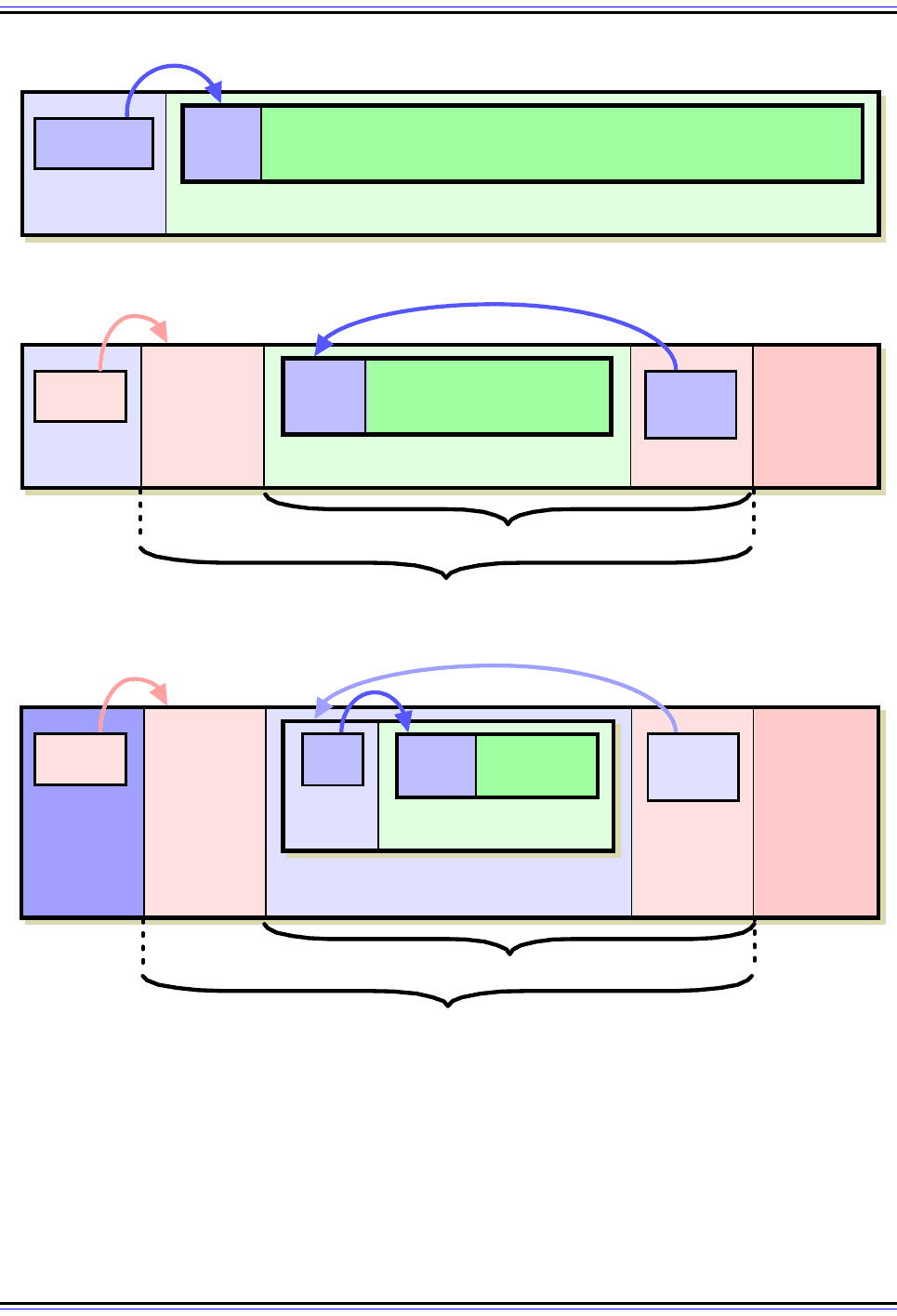
The TCP/IP Guide - Version 3.0 (Contents) ` 567 _ © 2001-2005 Charles M. Kozierok. All Rights Reserved.
Figure 125: IPv4 Datagram Format With IPSec Encapsulating Security Payload (ESP)
At top is the same sample IPv4 datagram shown in Figure 122. When this datagram is processed by ESP in
transport mode, the ESP Header is placed between the IPv4 header and data, with the ESP Trailer and ESP
Authentication Data following. In tunnel mode, the entire original IPv4 datagram is surrounded by these ESP
components, rather than just the IPv4 data. Again, as in Figure 124, note the encryption and authentication
coverage, and how the Next Header field “points back” to specify the identity of the encrypted data/datagram.
Encrypted Fields
Authenticated Fields
Original IPv4 Datagram Format
IPv4 Header IP Data
TCP
Header
TCP Segment Data
Protocol
6
New IPv4
Header
ESP
Header
Original IPv4 Datagram
(Encapsulated and Encrypted)
ESP Trailer
ESP Auth
Data
IPv4 Header IP Data
TCP
Header
TCP Data
Protocol
6
IPv4 Header ESP Header Encrypted IP Data ESP Trailer
ESP Auth
Data
TCP
Header
TCP Data
Protocol
50
Encrypted Fields
Authenticated Fields
IPv4 ESP Datagram Format - IPSec Transport Mode
IPv4 ESP Datagram Format - IPSec Tunnel Mode
Next
Header
6
Protocol
50
Next
Header
4

The TCP/IP Guide - Version 3.0 (Contents) ` 568 _ © 2001-2005 Charles M. Kozierok. All Rights Reserved.
Encapsulating Security Payload Format
The format of the ESP sections and fields is described in Table 81 and shown in Figure 126.
I have shown explicitly in each the encryption and authentication coverage of the fields,
which will hopefully cause all that stuff I just wrote to make at least a bit more sense.
The Padding field is used when encryption algorithms require it. Padding is also used to
make sure that the ESP Trailer ends on a 32-bit boundary. That is, the size of the ESP
Header plus Payload plus ESP Trailer must be a multiple of 32 bits. The ESP Authentication
Data must also be a multiple of 32 bits.
Table 81: IPSec Encapsulating Security Payload (ESP) Format
Section
Field
Name
Size
(bytes)
Description
Encryp-
tion
Coverage
Authenti-
cation
Coverage
ESP
Header
SPI 4
Security Parameter Index (SPI): A 32-bit
value that is combined with the destination
address and security protocol type to
identify the security association to be used
for this datagram. See the topic on security
associations for more details.
Sequence
Number
4
Sequence Number: A counter field
initialized to zero when a security associ-
ation is formed between two devices, and
then incremented for each datagram sent
using that SA. This is used to provide
protection against replay attacks.
Payload
Payload
Data
Variable
Payload Data: The encrypted payload
data, consisting of a higher layer message
or encapsulated IP datagram. May also
include support information such as an
initialization vector, required by certain
encryption methods.
ESP
Trailer
Padding
Variable
(0 to 255)
Padding: Additional padding bytes
included as needed for encryption or for
alignment.
Pad
Length
1
Pad Length: The number of bytes in the
preceding Padding field.
Next
Header
1
Next Header: Contains the protocol
number of the next header in the
datagram. Used to chain together headers.
ESP
Authentication Data
Variable
ESP Authentication Data: This field
contains the Integrity Check Value (ICV)
resulting from the application of the
optional ESP authentication algorithm.
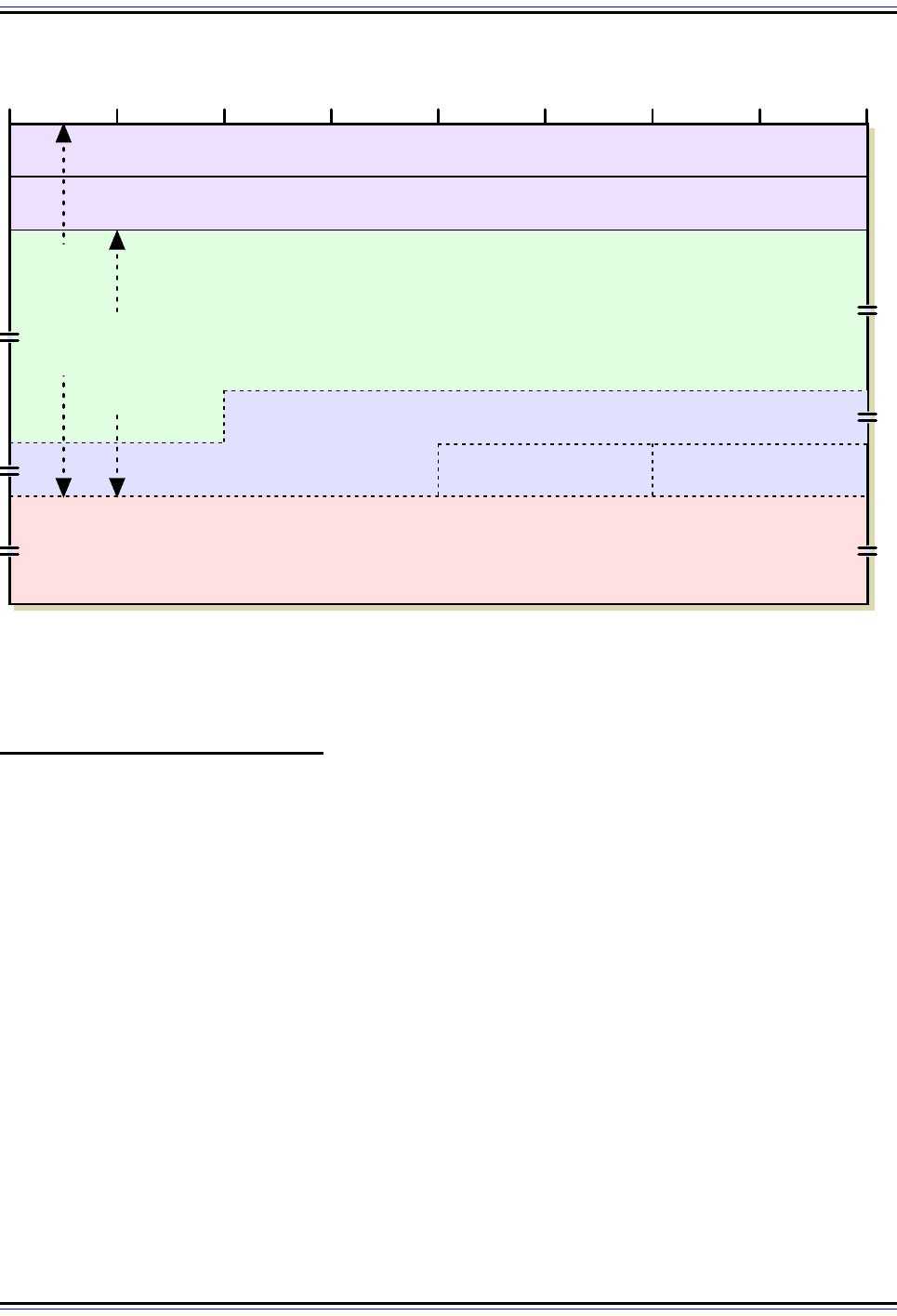
The TCP/IP Guide - Version 3.0 (Contents) ` 569 _ © 2001-2005 Charles M. Kozierok. All Rights Reserved.
IPSec Key Exchange (IKE)
IPSec, like many secure networking protocol sets, is based on the concept of a “shared
secret”. Two devices that want to send information securely encode and decode it using a
piece of information that only they know. Anyone who isn't “in” on the secret is able to
intercept the information but is prevented either from reading it (if ESP is used to encrypt
the payload) or from tampering with it undetected (if AH is used). Before either AH or ESP
can be used, however, it is necessary for the two devices to exchange the “secret” that the
security protocols themselves will use. The primary support protocol used for this purpose
in IPSec is called Internet Key Exchange (IKE).
IKE is defined in RFC 2409, and is one of the more complicated of the IPSec protocols to
comprehend. In fact, it is simply impossible to truly understand more than a real simplifi-
cation of its operation without significant background in cryptography. I don't have a
background in cryptography and I must assume that you, my reader, do not either. So rather
than fill this topic with baffling acronyms and unexplained concepts, I will just provide a brief
outline of IKE and how it is used.
Figure 126: IPSec Encapsulating Security Payload (ESP) Format
Note that most of the fields and sections in this format are variable length. The exceptions are the SPI and
Sequence Number fields, which are 4 bytes long, and the Pad Length and Next Header fields, 1 byte each.
Security Parameter Index (SPI)
Sequence Number
4 8 12 16 20 24 28 320
ESP Payload Data
Padding
Pad Length Next Header
ESP Authentication Data
Encrypted
Authenticated

The TCP/IP Guide - Version 3.0 (Contents) ` 570 _ © 2001-2005 Charles M. Kozierok. All Rights Reserved.
IKE Overview and Relationship to Other Key Exchange Methods
The purpose of IKE is to allow devices to exchange information required for secure commu-
nication. As the title suggests, this includes cryptographic keys used for encoding
authentication information and performing payload encryption. IKE works by allowing
IPSec-capable devices to exchange security associations (SAs), to populate their security
association databases (SADs). These are then used for the actual exchange of secured
datagrams with the AH and ESP protocols.
IKE is considered a “hybrid” protocol because it combines (and supplements) the functions
of three other protocols. The first of these is the Internet Security Association and Key
Management Protocol (ISAKMP). This protocol provides a framework for exchanging
encryption keys and security association information. It operates by allowing security
associations to be negotiated through a series of phases.
ISAKMP is a generic protocol that supports many different key exchange methods. In IKE,
the ISAKMP framework is used as the basis for a specific key exchange method that
combines features from two key exchange protocols:
☯ OAKLEY: Describes a specific mechanism for exchanging keys through the definition
of various key exchange “modes”. Most of the IKE key exchange process is based on
OAKLEY.
☯ SKEME: Describes a different key exchange mechanism than OAKLEY. IKE uses
some features from SKEME, including its method of public key encryption and its fast
re-keying feature.
IKE Operation
So, IKE doesn't strictly implement either OAKLEY or SKEME but takes bits of each to form
its own method of using ISAKMP. Clear as mud, I know. Since IKE functions within the
framework of ISAKMP, its operation is based on the ISAKMP phased negotiation process.
There are two phases:
☯ ISAKMP Phase 1: The first phase is a “setup” stage where two devices agree on how
to exchange further information securely. This negotiation between the two units
creates a security association for ISAKMP itself; an ISAKMP SA. This security associ-
ation is then used for securely exchanging more detailed information in Phase 2.
☯ ISAKMP Phase 2: In this phase the ISAKMP SA established in Phase 1 is used to
create SAs for other security protocols. Normally, this is where the parameters for the
“real” SAs for the AH and ESP protocols would be negotiated.
An obvious question is why IKE bothers with this two-phased approach; why not just
negotiate the security association for AH or ESP in the first place? Well, even though the
extra phase adds overhead, multiple Phase 2 negotiations can be conducted after one
Phase 1, which amortizes the extra “cost” of the two-phase approach. It is also possible to
use a simpler exchange method for Phase 2 once the ISAKMP security association has
been established in Phase 1.
